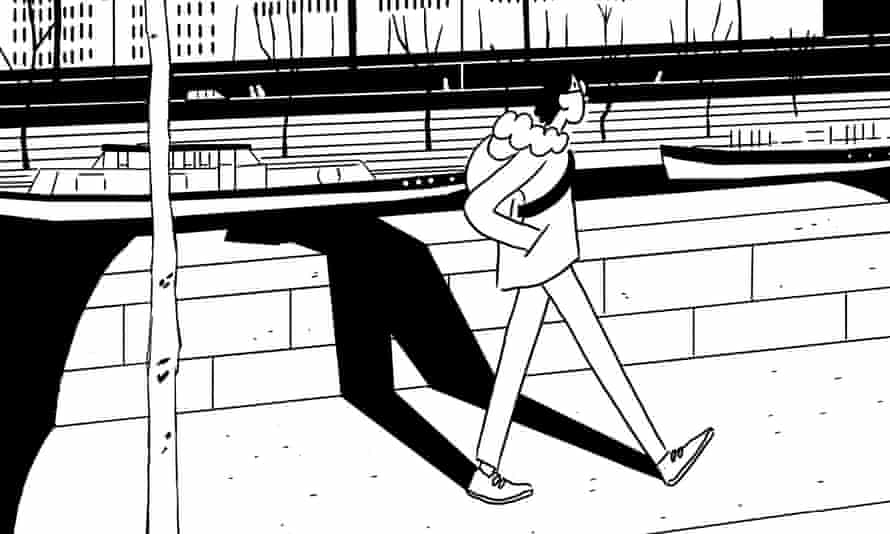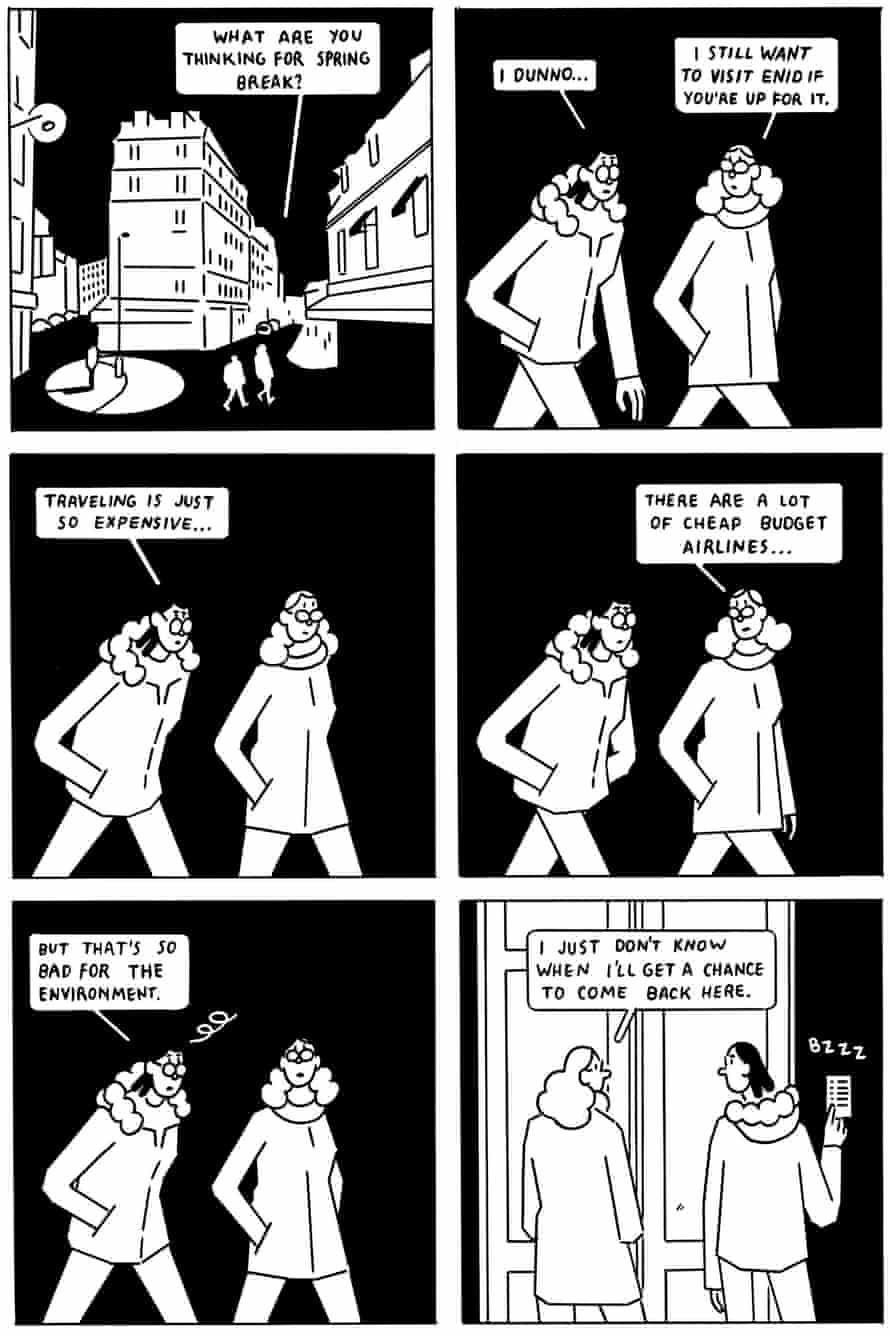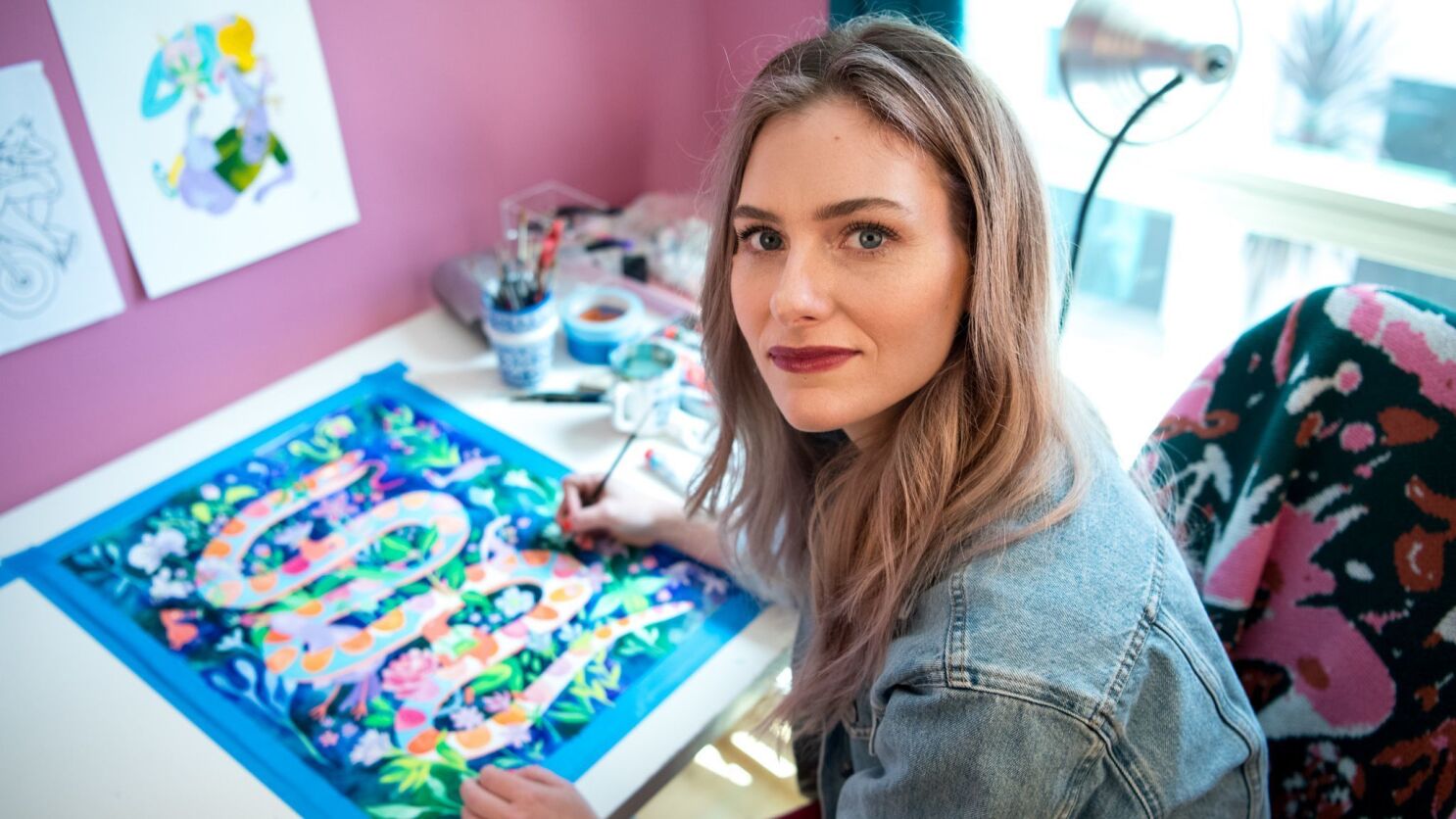Tag Archives: Lisa Hanawalt
May 31, 2021 Cartooning In and Out of Your Twenties
“Cartoon” can mean a lot of things. As a drawing style, those things usually include simplification. A cartoonist takes a massively detailed real-world subject and extracts the most defining elements and reproduces them through a few well-placed lines. The cartoonist also probably alters those lines, distorting them by selectively expanding and shrinking to create shapes that evoke but don’t match the original content. How simplified and how distorted offer wide spectrums, and every artist’s personal style is its own idiosyncratic cross-point on that simplify-distort grid.


Look at Sophie Yanow and Lisa Hanawalt. Both are renowned cartoonists, each with recent graphic novels (Yanow’s The Corrections and Hanawalt’s I Want You) released a month apart by their publisher Drawn & Quarterly last fall, but their styles occupy very distant locations in what they show to be the vast world of cartooning.
Yanow is a minimalist. Her protagonist—a younger version of herself in college—consists of a small repeating set of identical marks. Her eyes are the circles of her glasses perched on the tinier circle of her nose. Her mouth—sometimes a straight line identical to the straight lines that represent the stems of her glasses, sometimes a slightly curving smile or frown, and sometimes just a perplexed dot—does all of the work of expressing her limited emotions. Her body is even more geometric, elbows and knees often at right angles or undifferentiated in the straight lines of her straight limbs. The proportions are pleasantly odd too, her head a little too small, her torso a little too big, though not so exaggerated that she departs from a feeling of improbable naturalism.

The rest of Yanow’s world obeys the same simplified laws of reality. Some settings are evoked by even fewer lines, each the same unaltering thickness as the frame lines surrounding them. Yanow doesn’t draw a single crosshatch in her entire 200-page memoir. Either a shape is opaque black or empty white. Her layouts are equally consistent: six squares arranged in three rows of two. The few variations (white spaces replace panels during the final train ride home and when Yanow is finally alone and decompressing) are some of the most evocative moments in the memoir.
Hanawalt is a maximalist. Her protagonists—many of whom have animal heads but human bodies—consist of intricate patterns of fur and clothing, offset by comparatively sparse but equally intricate shapes that define their surroundings. Her crosshatching is often meticulous, giving realistic depth and texture to the characters’ exposed heads and limbs and so intensifying the surreal effect. When Hanawalt leaves the interior of shapes unshaded, the pages resemble absurdist coloring books wonderfully inappropriate for humans of any age.

Where Yanow champions blocky consistency, Hanawalt wanders through multiple layout variations. Some pages are single images, some are partitioned into single-line frames, other into gutters, and still others are entirely open-framed. Her rendering style roams just as freely, from thin-lined black to gray washes to opaque grays. While most of her lines are sharply precise, a few pages feature thicker looser art, as if an uncredited guest artist dropped by. Most are clearly Hanawalt-esque, though unexpected undertones of Shel Silverstein and Phoebe Gloeckner stroll through too.
Hanawalt’s free-roaming styles are well-suited to her collection, which (as her bird-headed cartoon self explains in the introduction) compiles her pre-animation (BoJack Horseman, Tuca & Bert) minicomics from 2009 and earlier. Though some characters recur (She-Moose and He-Horse get top billing), most are an anonymous cast of oddball humans and half-humans muddling through early 21st century existence. Though Hanawalt’s humor makes things a little more surreal (list of invented dances, instructions for pretending to jack-off while driving, things you can do nightmarishly wrong in grocery stores), but the baseline reality is uncomfortably familiar.
Though Yanow’s reality is explicitly real—The Contradictions documents a European hitchhiking trip she took while studying abroad—its unrelenting layout and style norms suggest the confused rigidity of her younger self as she struggles to navigate a paradoxically unpredictable world. Where Hanawalt is inventing a hybrid world in order to reflect on ours, Yanow’s younger self seems trapped in her own 3×2 gridded mindset which inaccurately partitions her experiences. She is a quietly unreliable visual narrator, unaware that her mismatched traveling companion and their awkward inability to relate is the source of her gently tragic disconnection.

Both cartoonists are drawing self-portraits, Hanawalt indirectly, Yanow explicitly. Their bodies and so their sexualities are part of their imagery. Yanow’s twenty-year-old self is openly gay, but she does not seem especially at ease with that fact—or possibly with any facts about herself. Though there is no overt sexual tension between her and her kleptomaniac anarchist friend Zena, the rules of plotting imply it, even as Yanow’s rules of representation stifle the possibility through a kind of visual asexuality. The characters seem lost inside the flat geometry of their clothes and bodies. The genre is coming-of-age, which Yanow quietly thwarts by allowing her cartoon self so little room for growth.
Hanawalt, however, is overt in her twenty-something sexuality. Where Yanow seems incapable of recognizing let alone expressing physical desire, Hanawalt’s title declares it as organizing principle. There are a few explicit sex acts (penis hula hoop, sexy real estate brokers, children’s dinosaur porn), but the grainy texture of animal fur surrounded by delicately patterned clothes implies what otherwise goes undrawn. Hanawalt’s half-humans are animals all the way down. We all are. Though she sometimes channels the sexual exuberance of Julie Doucet or Fiona Smyth, Hanawalt’s surreal bodies are also horror-tinged, often vomiting inexplicable clumps of noodles or baby chicks. The most disturbingly powerful sequence is She-Mouse’s visit to a surreal abortion clinic.
Despite their considerable differences in genre, style, and character temperament, Yanow and Hanawalt explore the same inexplicable underworld of longing, Yanow from the terrifying entry point of her twenties, and Hanawalt from the ravaged exit point of hers. Wanting and contradiction abound in both.


Tags: I Want You, Lisa Hanawalt, Sophie Yanow, The Contradictions
- Leave a comment
- Posted under Uncategorized
January 28, 2019 A Wilder West
I subtitle my advanced fiction writing course “Literary Genre,” which is a pairing of words most of my students haven’t seen before. Traditionally, so-called “literary fiction” and the array of genres that fall into the massive bin labeled “genre fiction” are understood to exist at opposite ends of some poorly defined spectrum. The confusion is complex, since”literary fiction” means both narrative realism (which IS a genre) and also “good fiction,” which has nothing to do with genres and so potentially applies to them all. It doesn’t help that a majority of genre fiction is formulaic and so really not literary in the second sense. Of course tons of narrative realism isn’t very good either.
So “literary genre fiction” is good fiction that uses tropes from traditional genres. Since a formulaic use of a trope tends to be predictable and plot- rather than character-driven, the trick is finding a way to evoke the qualities of a genre without simply repeating. Expectations must be thwarted. Something new has to grow out of that old terrain.
Take westerns, a uniquely U.S. genre that has mostly (though not entirely) fallen out of fashion. To write a literary western requires some repetition: can something be a western and not be set in the western U.S.? Horses and guns might be requisites too. But, like most genre, westerns have a slew of conventions that encode gender norms–redemptively violent men saving not-strong-enough women–that I hope any contemporary writer would avoid like a snake bite.
My fiction-writing class is prose-only, so I didn’t put Lisa Hanawalt’s graphic novel Coyote Doggirl on the syllabus. But since it’s an ideal example of literary genre, maybe I should have. It features a wild west as familiar as tumbleweeds yet newly invigorated by a comics artist’s feminist eye. Hanawalt roams the border lands between cartoon and naturalism, nostalgia and invention, ribald slapstick and social commentary, all while satisfying each of their disparate and often contradictory genre norms.

In the tradition of anthropomorphic animals—Buggs Bunny, Winnie the Pooh, Garfield—Hanawalt’s main character is essentially a human with a dog’s head. In this canine universe, everyone is dog-headed. She has fingers and toes, wears long pants and a “crop halter top” (which she designed herself!), and has ears that stick straight up above her snout of a face.
But though Doggirl is a cartoon character in a cartoon world, Hanawalt infuses that world with a surprising level of visual realism. If it’s never bothered you that an anthropomorphic mouse named Mickey has a semi-anthropomorphic pet dog named Pluto, then Doggirl’s pony “Red” will bother you even less. Unlike his owner, Red is thoroughly realistic. Hanawalt renders him with loving precision. While Doggirl is almost entirely devoid of anatomy-defining, internal lines, Hanawalt gives Red and other horses just enough to suggest fully realized bodies–ones that include skeletons and musculature that the dog people lack. The shadow that Red casts on the cover is evidence alone that she is drawing from real-world references—corroborated by her one sentence bio “Lisa Hanawalt lives and rides in Los Angeles” and the nine names in her list of “Some favorite horses Lisa has known.”
Doggirl’s setting is more realistic than her too. While Hanawalt’s style creates a minimalistic impression, pausing on an image allows the eye to travel over a surprising range of details—most of it in the rendering of desert and mountain plants. This world is further deepened by Hanawalt’s colors, which highlight the quirks of her brushes, giving watercolor texture to otherwise flat plains and barren skies. The openness of the western setting is also reflected in the formal choice of her unframed panels, usually three or four per page. The physical format of the book is small, about seven and a half by six inches, but the dimensions are offset by the expansive layout and bright color palette.
Hanawalt occasionally uses single-line frames too, but she avoids formal gutters except to differentiate a flashback sequence which she colors darker too. The stylistic choices are apt as Doggirl narrates escaping an attempted rape and the justified mutilation of her attacker. The event is the core of the novel’s nominal plot, driving the main character from episode to comic episode as her attacker’s brother and his two thugs pursue her for revenge.
It may sound like a typical western set-up, but in Hanawalt’s capable hands it also encompasses genre parody and gender critique. Doggirl’s minimalistic form is a welcome counterpoint to a genre that traditionally exploits female bodies both visually and narratively. When a plot point suggests an occasion for nudity, Hanawalt draws Doggirl either only partially or from behind—and then without a teasing array of crosshatched shadows that indirectly suggest the undrawn contours of exposed breasts.

But Doggirl isn’t sexually neutral either. An opening page tilted “Coyote’s Wish List” includes a “pleasure saddle” drawn with an impressive array of dildo attachments. It’s one of Hanawalt’s many tossed-off gags. Though she can be unabashedly crude, the overall tone of the novel is oddly subtle—as when the arrow-wounded Doggirl collapses, mumbling “There’s dirt in my ear.” The bird pecking at her blood puddle adds a macabre secondary punchline. While humor is the novel’s most immediate appeal, Hanawalt uses it often to complex effect, as when she draws Doggirl’s would-be rapist’s leg as if it’s been meticulously sliced by deli machine. I laughed, even internally applauded, but not without discomfort.

Doggirl is her own hero, saving herself not just from her attacker but eventually from her pursuers too. While Hanawalt is happy to include a bit of gun and knife action, ultimately Doggirl saves the day by talking herself out of trouble and more than one genre cliché. Thugs are not your typical thugs in this doggy universe. Hanawalt’s Indians are even more complex—neither savages nor noble innocents, but an odd collection of individuals happy to give aid, but only after causing pointless harm.
Coyote Doggirl is proof that even a genre as seemingly played-out as the western can reveal a rich landscape if the right hands are holding the reins.

[A version of this post and my other recent reviews appear in the Comics section of PopMatters.]
Tags: Coyote Doggirl, Lisa Hanawalt
- Leave a comment
- Posted under Uncategorized








